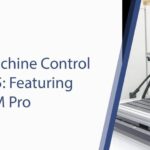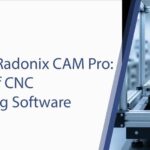In the modern woodworking industry, the ability to produce intricate designs with unparalleled precision and efficiency is no longer a luxury—it’s a necessity.
At the heart of this transformative capability lies CNC software woodworking, the digital brain that translates your creative vision into tangible, perfectly crafted wooden pieces.
Understanding and choosing the right software is paramount to unlocking the full potential of your CNC router, enabling you to elevate your craftsmanship and streamline your production.
This article will delve deep into the world of CNC software woodworking, exploring its types, functionalities, and how Radonix solutions empower woodworkers worldwide.
Why is the Right CNC Software Woodworking Essential for Your Business?
In today’s competitive woodworking market, simply owning a CNC machine isn’t enough.
The true differentiator lies in how effectively you utilize that machine, and this effectiveness is directly tied to your CNC software for woodworking.
The right software empowers you to:
- Achieve Unmatched Precision and Quality: Advanced CNC software woodworking allows for intricate toolpath generation, precise material removal, and complex geometric designs that are impossible to replicate manually. This leads to higher quality products with minimal imperfections.
- Boost Production Efficiency and Speed: Automated processes, optimized toolpaths, and efficient nesting features significantly reduce machining time and material waste, leading to higher output and faster project completion.
- Minimize Material Waste: Sophisticated nesting algorithms in CNC software for woodworking arrange parts on your material sheet to maximize utilization, reducing scrap and saving on costly wood.
- Reduce Human Error and Rework: By automating design and machining, the likelihood of manual errors is drastically cut. This means fewer scrapped pieces and less time spent on rework, leading to significant cost savings.
- Unlock Design Versatility and Creativity: With powerful design tools, you can create virtually any shape or form, opening up new possibilities for custom furniture, intricate carvings, cabinetry, and more.
- Streamline Workflow and Reduce Lead Times: From design to execution, the right CNC software for woodworking integrates seamlessly into your workflow, allowing for quicker iteration, prototyping, and faster delivery to your clients.
- Enhance Safety: By automating dangerous cutting processes, CNC machines, guided by robust software, significantly improve workshop safety for operators.
Investing in the right CNC software for woodworking isn’t just an expense; it’s a strategic investment that directly impacts your profitability, competitiveness, and capacity for innovation.
The Fundamental Types of CNC Software for Woodworking
CNC software for woodworking typically falls into three main categories, each serving a distinct purpose in the overall workflow:
1. CAD Software (Computer-Aided Design)
CAD software is where your woodworking ideas first come to life digitally.
It allows you to create detailed 2D drawings and 3D models of your projects.
- Functionality:
- 2D Sketching and Drafting: For creating profiles, outlines, and basic shapes of your parts. This is crucial for precise dimensions and joinery.
- 3D Modeling: For designing complex three-dimensional objects, visualizing how parts fit together, and creating intricate carvings or contours.
- Assembly Design: Allowing you to virtually assemble multiple components to ensure proper fit and function before any material is cut.
- Parametric Design: Some CAD software allows for parametric modeling, where dimensions and relationships between features can be easily modified, automatically updating the entire design. This is invaluable for custom sizing or design variations.
- Popular CAD Software for Woodworking:
- SketchUp: User-friendly, good for initial design concepts and basic 3D modeling.
- Fusion 360: A comprehensive cloud-based platform offering robust 3D modeling capabilities, often including integrated CAM.
- SolidWorks/AutoCAD: More industrial-grade, offering extensive features for complex designs, often used by larger operations.
- VCarve Desktop/Pro (from Vectric): While primarily CAM, these also include powerful 2D design tools that are excellent for woodworking.
- Radonix Relevance: While Radonix focuses on the control aspects, our systems are designed to seamlessly integrate with designs created in all industry-standard CAD software.
2. CAM Software (Computer-Aided Manufacturing)
CAM software is the bridge between your design and your CNC machine. It takes the CAD model and generates the specific instructions (G-code) that the CNC router understands.
- Functionality:
- Toolpath Generation: This is the core function, defining the exact path the cutting tool will follow to remove material. This includes roughing, finishing, pocketing, profiling, drilling, and carving toolpaths.
- Tool Library Management: Storing information about various cutting tools (diameter, flute length, feed rates, spindle speeds) to ensure optimal machining parameters.
- Feed and Speed Optimization: Calculating the ideal cutting parameters (feed rate, spindle RPM) based on the material, tool, and desired finish.
- Nesting: Optimizing the layout of multiple parts on a sheet of material to minimize waste, a critical feature for efficiency in CNC software woodworking.
- Simulation: Visualizing the toolpath before machining begins, allowing you to identify potential errors, collisions, or inefficient cuts, saving material and machine time.
- Post-Processing: Converting the generic toolpath data into specific G-code that your particular CNC machine’s controller can interpret. This is where the compatibility between CAM and the CNC controller is crucial.
- Popular CAM Software for Woodworking:
- VCarve Desktop/Pro (Vectric): Highly popular in woodworking for its user-friendliness, powerful 2D and 2.5D machining capabilities, and excellent support for typical woodworking operations.
- Aspire (Vectric): Builds on VCarve with advanced 3D modeling and carving features.
- Fusion 360 (CAM module): Offers integrated CAM alongside CAD, making it a powerful all-in-one solution.
- Alphacam: A robust industrial CAM solution for complex 3D machining and multi-axis applications.
- Cabinet Vision: Specialized for cabinet making, automating much of the design and CAM process for this niche.
- Radonix Relevance: Our CNC control systems are designed with extensive compatibility in mind. Radonix controllers can flawlessly interpret G-code generated by all leading CAM software solutions, ensuring a smooth transition from design to machining for your CNC software woodworking workflow.
3. CNC Control Software (Machine Control Software)
This software acts as the direct interface between the operator and the CNC machine’s hardware (the controller itself, often a Radonix unit).
It loads the G-code from the CAM software and sends commands to the machine’s motors and other components.
- Functionality:
- G-code Loading and Execution: Reading the generated G-code file and sending real-time commands to the machine’s axes.
- Machine Homing and Jogging: Allowing the operator to precisely move the machine’s axes to set up the workpiece and establish home positions.
- Spindle Control: Managing the on/off state and speed of the spindle motor.
- Tool Changer Management: For machines with automatic tool changers, managing the tool change sequence.
- Real-time Monitoring: Displaying the current position of the tool, spindle speed, feed rate, and other critical machine parameters.
- Safety Features: Implementing emergency stops, limit switch monitoring, and other safety protocols.
- Manual Data Input (MDI): Allowing operators to input single G-code commands for quick operations.
- Program Editing (Basic): Some control software allows for minor on-the-fly G-code edits.
- Machine Calibration and Configuration: Setting up machine parameters, motor tuning, and other crucial configurations.
- Popular CNC Control Software (often bundled with controllers):
- Mach3/Mach4: Widely used for hobbyist and light industrial machines, offering extensive customization.
- LinuxCNC: An open-source, highly customizable control system popular in DIY and professional settings.
- Grbl (for Arduino-based systems): Simple, open-source firmware for smaller, entry-level CNC machines.
- Radonix CNC Control Software: Our proprietary software is designed to perfectly match our robust hardware controllers.
- Radonix Relevance: At Radonix, our primary expertise lies in developing state-of-the-art CNC controllers and their accompanying control software. Our CNC software for woodworking machine control is engineered for:
- Unparalleled Reliability: Ensuring consistent, error-free operation even during long production runs.
- Intuitive User Interface: Designed for ease of use, reducing the learning curve for operators.
- High Performance: Optimized to deliver precise, smooth, and fast motion control for superior cutting results.
- Extensive Compatibility: Capable of interpreting G-code from virtually any CAM software.
- Robust Safety Features: Prioritizing operator and machine safety with comprehensive monitoring and E-stop protocols.
- Customization and Scalability: Our solutions can be tailored to various woodworking machine configurations and scaled from hobbyist to industrial levels.
Key Features to Look for in CNC Software Woodworking
When evaluating CNC software woodworking solutions, consider these critical features that impact performance and usability:
- Ease of Use & Learning Curve: How intuitive is the interface? Is there extensive documentation and community support? A steep learning curve can cost valuable time and money.
- Design Capabilities (CAD): Does it offer the 2D and 3D modeling tools you need for your projects? Consider parametric design if you often create custom or variable-sized pieces.
- Toolpath Generation & Optimization (CAM): Look for features like advanced nesting, roughing and finishing strategies, drilling cycles, and the ability to handle complex 3D contours. Optimization algorithms are key for efficiency.
- Simulation & Visualization: A robust simulation tool is invaluable for detecting errors before cutting, saving material and preventing machine damage.
- Post-Processor Compatibility: Ensure the CAM software can generate G-code compatible with your specific CNC controller (like Radonix controllers).
- Machine Control Features: Check for real-time monitoring, manual control options, robust error handling, and comprehensive safety protocols.
- Material Libraries: Software that includes or allows you to create custom material libraries (with specific cutting parameters for different wood types) can greatly streamline workflow.
- Tool Libraries: The ability to manage and define various cutting tools, including their geometry and recommended cutting parameters, is crucial.
- Automation & Scripting: For repetitive tasks, advanced users might look for scripting capabilities to automate certain processes.
- Support & Community: Reliable customer support, online forums, and tutorial libraries are essential for troubleshooting and learning.
- Scalability: Can the software grow with your business? If you plan to upgrade your CNC machine or expand your operations, can the software handle it?
The Workflow: From Concept to Cut with CNC Software Woodworking
Understanding the typical workflow helps clarify how different types of CNC software for woodworking integrate:
- Concept & Design (CAD): You begin by sketching out your idea, whether it’s a simple shelf bracket or a complex furniture piece. This is done in your chosen CAD software, where you define dimensions, shapes, and relationships.
- Toolpath Creation (CAM): Once your design is complete, you import it into your CAM software. Here, you define the cutting tools you’ll use, set depths of cut, select cutting strategies (e.g., climb cut vs. conventional cut), and generate the toolpaths. If you have multiple parts, this is where nesting comes into play. The CAM software then outputs a G-code file.
- Machine Setup & Control (CNC Control Software – Radonix): You load the G-code file into your CNC control software (e.g., Radonix’s proprietary software). You’ll then home the machine, set your workpiece origin (zero point), and perform any necessary tool changes. The control software sends the G-code commands to the CNC machine’s motors and components.
- Execution & Monitoring: The CNC machine begins cutting, following the G-code instructions precisely. The control software continuously monitors the machine’s progress, tool position, and other parameters, displaying them in real-time. Operators can pause, stop, or adjust feed rates on the fly if needed.
- Finishing: Once the machining is complete, you remove the part, perform any necessary sanding, finishing, or assembly.
Radonix plays a pivotal role in the “Machine Setup & Control” and “Execution & Monitoring” phases, ensuring the precise and reliable execution of your designs. Our CNC software woodworking control systems are designed to be the robust and intuitive backbone of your machining process.
Radonix Solutions: Empowering Your Woodworking with Superior CNC Control Software
At Radonix, we understand the unique demands of the woodworking industry. Our CNC control systems are specifically engineered to deliver performance, reliability, and ease of use, making them an ideal choice for your CNC software woodworking needs.
- Optimized for Woodworking Precision: Our controllers and software are fine-tuned to handle the specific requirements of woodworking, from intricate carving to high-speed panel processing.
- Seamless Integration: Radonix controllers are built to be compatible with G-code generated by all major CAM software used in woodworking, ensuring a smooth transition from design to production.
- Intuitive Interface: Our proprietary CNC control software features a user-friendly interface that reduces the learning curve for operators, allowing them to quickly become proficient.
- Robust Performance: Engineered for continuous operation, our systems deliver consistent precision and speed, even during demanding production cycles.
- Comprehensive Safety Features: We prioritize operator and machine safety with built-in emergency stop protocols, limit switch monitoring, and intelligent error handling.
- Reliable Support: As a Radonix customer, you gain access to our expert technical support team, ready to assist with any queries or challenges, ensuring your operations run smoothly. You can find more information and contact us through Radonix.
- Scalable Solutions: Whether you’re a small workshop or a large manufacturing facility, Radonix offers controllers and software solutions that can be scaled to meet your current and future production needs.
The Future of CNC Software Woodworking
The landscape of CNC software for woodworking is continuously evolving, driven by advancements in artificial intelligence (AI), machine learning (ML), and the Internet of Things (IoT). Radonix is at the forefront of these innovations, envisioning a future where:
- AI-Driven Toolpath Optimization: Software will use AI to automatically generate the most efficient toolpaths, considering material properties, tool wear, and desired finish, potentially even suggesting optimal cutting tools.
- Predictive Maintenance: CNC software for woodworking will integrate with machine sensors to monitor components in real-time, predicting potential failures before they occur and scheduling maintenance proactively, minimizing downtime.
- Automated Design Generation: AI could assist in generating design variations or even complete designs based on user input and specific parameters, further accelerating the design process.
- Cloud-Based Collaboration: More CNC software woodworking will leverage cloud platforms for seamless collaboration, remote monitoring, and access to vast material and tool libraries.
- Robotics Integration: Advanced software will enable easier integration of robotic arms for material handling, automated tool changes, and complex multi-axis operations.
- Enhanced Simulation with Physics Engines: Simulations will become even more realistic, incorporating real-world physics to predict material behavior, chip evacuation, and tool deflection.
Radonix is committed to incorporating these cutting-edge technologies into our future CNC control systems and software, ensuring that our clients remain competitive and at the forefront of woodworking innovation.
Conclusion
CNC software for woodworking is the indispensable foundation for modern woodworking. From conceptual design in CAD to precise G-code generation in CAM, and finally, to flawless execution via robust CNC control software, each piece plays a critical role.
Choosing the right software ecosystem empowers woodworkers to achieve unprecedented levels of precision, efficiency, and creative freedom.
At Radonix, we specialize in providing high-performance CNC control software that serves as the reliable command center for your woodworking machinery.
Our solutions are designed to be intuitive, robust, and compatible with the industry’s leading CAD/CAM platforms, ensuring a seamless and productive workflow for you.
We invite you to explore our range of CNC control solutions and learn how Radonix can elevate your woodworking operations. Visit Radonix for more information and to connect with our expert team.
Contact Us:
- E-Mail: info@radonix.com
- Phone: +90 (553) 920 5500








